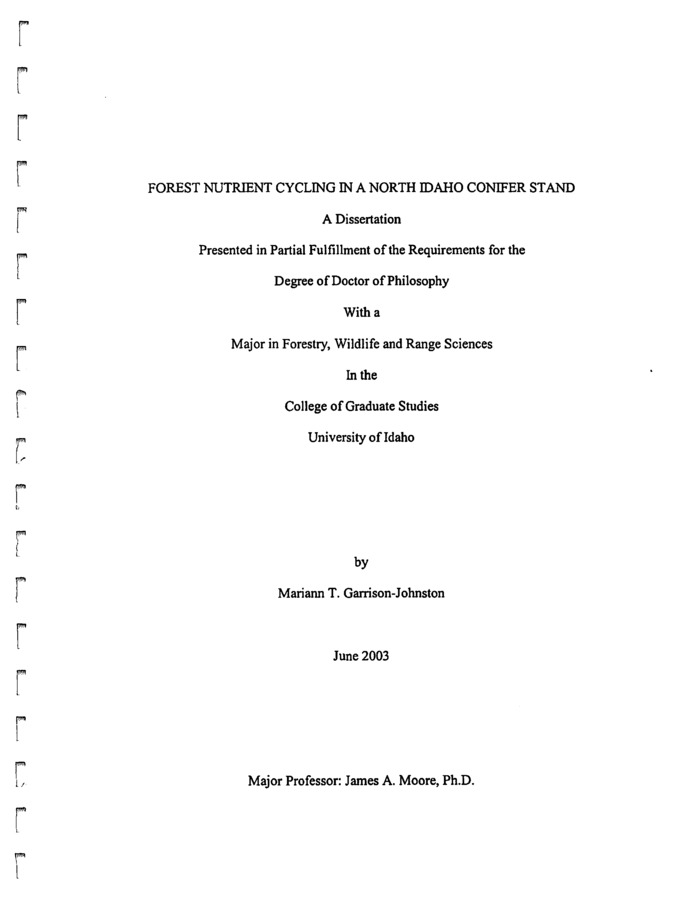PDF
Forest Nutrient Cycling in a North Idaho Conifer Stand Item Info
- Title:
- Forest Nutrient Cycling in a North Idaho Conifer Stand
- Creator:
- Garrison-Johnston, M.T.
- Date Created (ISO Standard):
- 2003-06-01
- Description:
- Overstory, understory, forest floor and soil elemental contents and litterfall flows of all macronutrients and most micronutrients and aluminum were measured during one growing season in a north Idaho conifer stand. These data were analyzed for differences which might explain past variation in fertilization response. The first phase of the study involved the examination ofsoil nutrient availability as measured by ion exchange resins. Goals were to detect possible causes of variation in past fertilization response, to develop an improved understanding ofseasonal nutrient dynamics, and to examine changes in soil nutrient availability throughout the soil profile. Using ion-exchange resins, differences in elemental availability were detected by experimental block, as well as with soil depth and throughout the growing season. Results were discussed in light of findings by other researchers and used to help explain possible reasons for past variation in forest fertilization response. Soil nutrient availability was also compared to tree nutrient uptake throughout the growing season using graphical interpretation, and correlation analysis was perfonned between Douglas-fir foliar nutrient concentrations and ioin-exchange nutrient availabilitiy. Several interesting findings regarding interpretation ofion-exchange data in light oftree nutrient uptake were discussed. During the second phase ofthis study, differences in macronutrient, micronutrient and aluminum contents ofvarious forest ecosystem components were analyzed and evaluated during one growing season. Block differences in overstory and litterfall contents that may help explain past fertilization response at this site are discussed. Needle attributes of overstory trees showed significant differences by species, crown class, crown position, foliar age class and sampling date. Foliar weight varied with the degree of foliage exposure to sunlight, and elemental foliar contents generally followed the same pattern. Understory vegetation showed significant nutrient content differences between growth fonns and during the growing season for several elements. Litterfall dry weight and elemental contents showed seasonal variation, and forest floor content ofmost elements was within expected ranges. The final phase ofthis study entailed the compilation ofoverstory, understory, forest floor and soil elemental contents and litterfall flows into a systems analysis model, which was then projected over a three-year period. Model simulations were perfonned for three species composition scenarios, including pure grand fir, pure Douglas-fir and mixed conifer. For all species simulations, model components and flows were examined, and both seasonal and annual behavior were evaluated in biological and mechanistic terms. Significant differences in overstory elemental content and related flows were revealed through simulation of various species compositions. Overall, systems analysis was a useful tool for evaluating forest elemental cycling, and provided a better understanding of seasonal and short-tenn nutrient dynamics and component interactions of our experimental stand. Suggestions for future research are discussed in light ofthese findings.
- Subjects:
- research fertilizer timber (lumber) statistics
- Source:
- Garrison-Johnston, M.T., 2003. Forest nutrient cycling in a north Idaho conifer stand. Ph.D. Dissertation, University of Idaho, Moscow, Idaho, 198p.
- Source Identifier:
- Forest_Nutrient_Cycling_in_a_North_Idaho_Conifer_Stand_UIGradStudies_2003
- Type:
- Text
- Format:
- application/pdf
Source
- Preferred Citation:
- "Forest Nutrient Cycling in a North Idaho Conifer Stand", Intermountain Forestry Cooperative, University of Idaho Library Digital Collections, https://www.lib.uidaho.edu/digital/iftnc/items/iftnc4539.html
Rights
- Rights:
- This document is provided by the University of Idaho Library for use by University of Idaho students, staff, and faculty. All rights to the document linked from this metadata belong to the author, rights holder, and/or provider. For more information contact The Intermountain Forestry Cooperative, https://www.uidaho.edu/cnr/ifc
- Standardized Rights:
- http://rightsstatements.org/vocab/InC-EDU/1.0/

